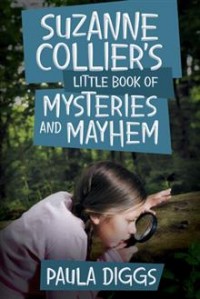Title: Suzanne Collier’s Little Book of Mysteries and Mayhem
Author: Paula Diggs
Publisher: iUniverse
ISBN: 9781491771402
Pages: 258
Genre: Juvenile Fiction / Action & Adventure / General
Reviewed by: Allison Walker
Buy on AmazonPacific Book Review
Suzanne Collier is not a future detective, she is a real detective and she keeps her eyes open and her nose sniffing for clues to solve. Her penchant for snooping and eavesdropping lead her to exciting, sometimes dangerous, mysteries and adventures. But Suzanne’s stories aren’t just for detectives and crime fighters, even young actors and scientists will be able to relate to Suzanne’s story, as her troubles reflect those of a troubling age: staying out of mischief at school, practicing her flute which she detests, struggling to make friends, and getting along with her little sister.
Written in first person, as though narrated by Suzanne Collier herself, the story unfolds from the watchful eyes of a seven-year-old detective. Smart and observant, Suzanne’s virtues sometimes prove to be her vices, often exasperating her mother, and leading her to be bullied at school.
Author Paula Diggs’ observations and the way she translates them to a young girl’s point of view is one of her most notable strengths as an author in the telling of Suzanne Collier’s Little Book of Mysteries and Mayhem. Diggs is so accurate the story becomes a truly fascinating insight into the mind of a seven-year-old girl. The things Suzanne sees, hears and says are surprising and endearing. Her opinions are incredibly perceptive, and sprinkled with the perfect mixture of childish misunderstanding and realistic events. For example, many of the things the adults in her life do are completely peculiar to Suzanne, but totally reasonable from an adult’s perspective. In this way, Suzanne’s observations and retellings are very fun to read.
The stories are fast-paced and exciting, appropriate and necessary for a children’s novel, and made even more entertaining by Suzanne’s Amelia Bedelia-like observations. In one chapter, after winning the marbles competition at school, Suzanne decides she must train for a race when she learns her classmate’s mother is “fit to be tied” over her winning. Suzanne is sure she is fit enough, and the race will not be a tie, and she will win.
Paula Diggs does a wonderful job using classic literary tools throughout Suzanne’s narrative. Diggs uses a lot of foreshadowing, inserted as distracted snippets from a seven-year-old telling of the tale. Certain themes appear and reappear, subtly, again, brief observations from a short attention span. The narrative is reflective of, and stays true to a young girl’s report. The story reads the way Suzanne thinks: often distractedly, usually in incomplete sentences, and with the clumsy dialogue of a child. Sometimes the story is too much like a child’s journal: separate ideas populate the same paragraph, changing trains of thought in the space of a single period, and making the story discombobulated. The abrupt sentences are sometimes difficult to follow.
What makes Diggs’ little book so valuable as a children’s story is that Suzanne is not always the smartest, or prettiest, or most popular. She carries her dolls everywhere, is afraid of moving to a new house, and does not have a lot of friends. But Suzanne never stops trying, and even at her scariest moments, Suzanne is able to draw on her inner strength, beat her fears, and overcome any obstacle. As a character, Suzanne is relatable and inspiring.
Suzanne Collier’s Little Book of Mysteries and Mayhem is made up of crime stories for children. Parents be warned: these mysteries are tough. Mobsters, con men, and kidnappers chase Suzanne and threaten the well being of her dearest friends. Suzanne must use all her wits to escape these foes and solve the mystery.



Follow Us